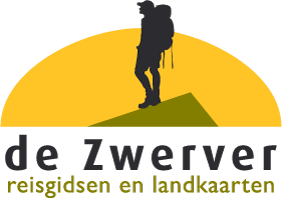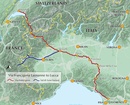Guidebook to the Via Francigena pilgrim route from Lausanne to Lucca. Starting at Lake Geneva (Lac Léman), the 725km route crosses the Alps at historic Great Saint Bernard Pass, descends the Po Valley, then climbs to cross the Cisa Pass into Tuscany. Described in 32 stages, with information on facilities and pilgrim hostels.
Seasons
Suitable for walking in spring, summer and autumn. The Great Saint Bernard Pass is fully open to hikers only in August and September.
Centres
Lausanne, Martigny, Great Saint Bernard Pass, Aosta, Ivrea, Vercelli, Pavia, Piacenza, Pontremoli, Pietrasanta, Lucca.
Difficulty
Each stage is graded for difficulty (1-4). A few mountainous stages include steep and slippery slopes. No special gear is required to walk the Via Francigena in season, but off-season crossings of the Great Saint Bernard Pass require winter mountain gear and careful attention to changing mountain conditions.
Must See
Dazzling Lake Geneva, the 1500-year-old Abbey of Saint-Maurice, the spectacular 2469m Great Saint Bernard Pass across the Alps, the emerald peaks of Italy's Aosta Valley, well-preserved medieval cities of Vercelli, Pavia and Piacenza, spectacular views from the Monte Valoria at the Cisa Pass, resorts of the Lunigiana coastline and the charming walled city of Lucca.
An indispensable guidebook to walking the Via Francigena between Lausanne and Lucca. This is the middle section of the pilgrim route connecting Canterbury to the Vatican City in Rome, and passes through some of the Via Francigena's most beautiful and dramatic scenery. Starting at Lake Geneva (Lac Léman) in Switzerland, the 725km route crosses the Alps into Italy at historic Great Saint Bernard Pass, descends through the Aosta Valley to the Po Valley, then climbs again to cross the Cisa Pass into Tuscany.
The route is described in 32 day stages averaging around 23km a day, but can easily be customised to other itineraries. It is suitable for any averagely fit walker, although there are a few steep mountainous stages. Relevant variants are described, including options to make use of boat, bus and train connections, and it is possible to cycle all or part of the Italian portion of the route.
In this guidebook, full stage directions are accompanied by maps showing the route line and the facilities available at different locations. Accommodation listings give invaluable information on low-cost pilgrim hostels and where to stay. There are useful city maps for Lausanne, Aosta, Ivrea, Pavia, Piacenza and Lucca, and a stage planning table lists intermediate distances between accommodation providers, so you can customise your own walking schedule. One of three volumes covering the complete Via Francigena.
Section 1: The Vaud and Valais
Stage 1 Lausanne to Vevey
Stage 2 Vevey to Aigle
Stage 3 Aigle to Saint-Maurice
Stage 4 Saint-Maurice to Martigny
Stage 5 Martigny to Orsières
Stage 6 Orsières to Bourg-Saint-Pierre
Stage 7 Bourg-Saint-Pierre to Col du Grand-Saint-Bernard
Section 2: Aosta Valley
Stage 8 Col du Grand-Saint-Bernard to Aosta
Stage 9 Aosta to Châtillon
Stage 10 Châtillon to Verrès
Stage 11 Verrès to Pont-Saint-Martin
Section 3: Piemonte
Stage 12 Pont-Saint-Martin to Ivrea
Stage 13 Ivrea to Viverone
Stage 14 Viverone to Santhià
Stage 15 Santhià to Vercelli
Variant Val di Susa to Vercelli
Section 4: Lombardia
Stage 16 Vercelli to Robbio
Stage 17 Robbio to Mortara
Stage 18 Mortara to Garlasco
Stage 19 Garlasco to Pavia
Stage 20 Pavia to Santa Cristina e Bissone
Stage 21 Santa Cristina e Bissone to Orio Litta
Stage 22 Orio Litta to Piacenza
Section 5: Emilia-Romagna
Stage 23 Piacenza to Fiorenzuola d’Arda
Stage 24 Fiorenzuola d’Arda to Fidenza
Stage 25 Fidenza to Fornovo di Taro
Stage 26 Fornovo di Taro to Berceto
Stage 27 Berceto to Pontremoli
Section 6: Liguria and Tuscany
Stage 28 Pontremoli to Aulla
Stage 29 Aulla to Sarzana
Stage 30 Sarzana to Massa
Stage 31 Massa to Camaiore
Stage 32 Camaiore to Lucca















